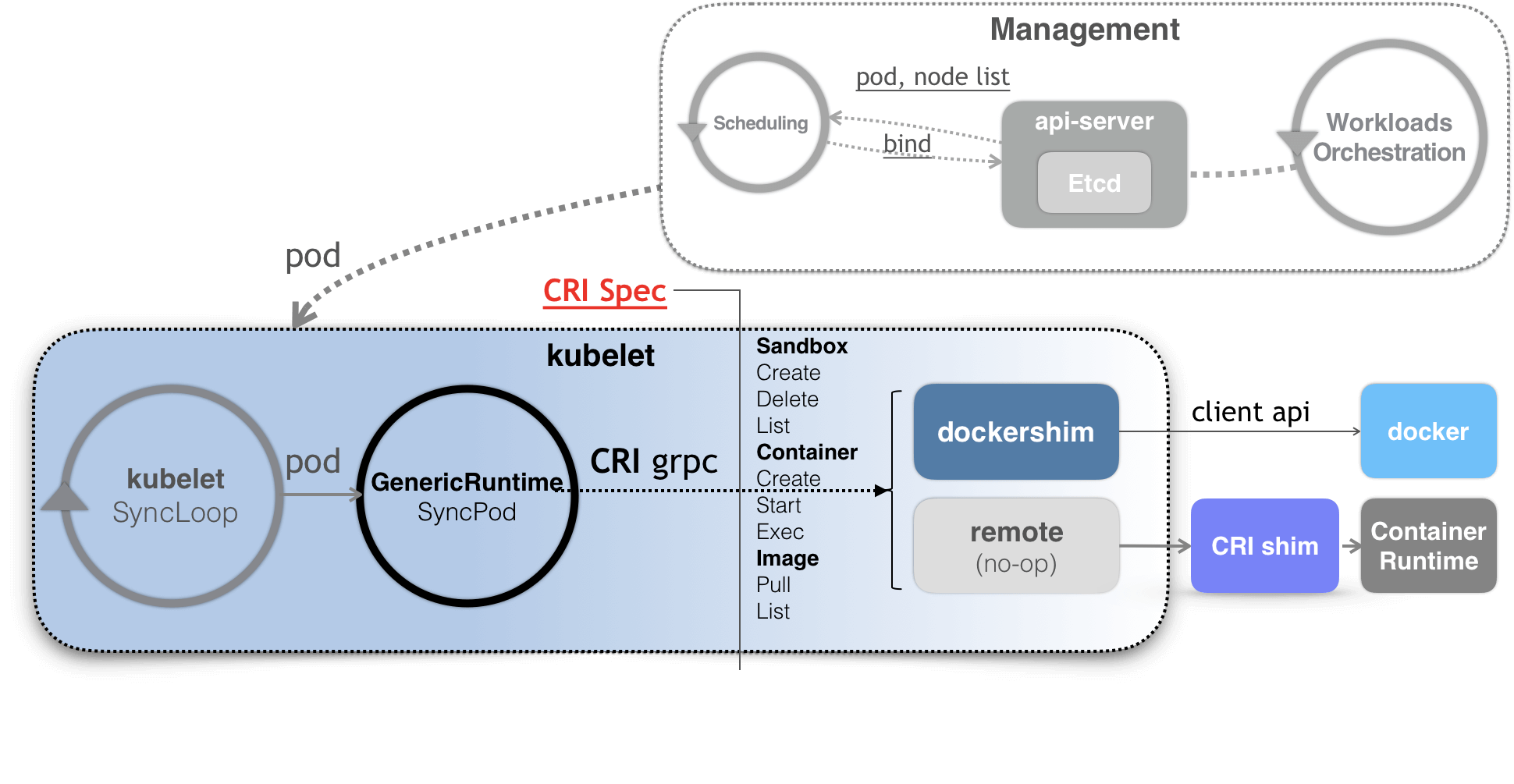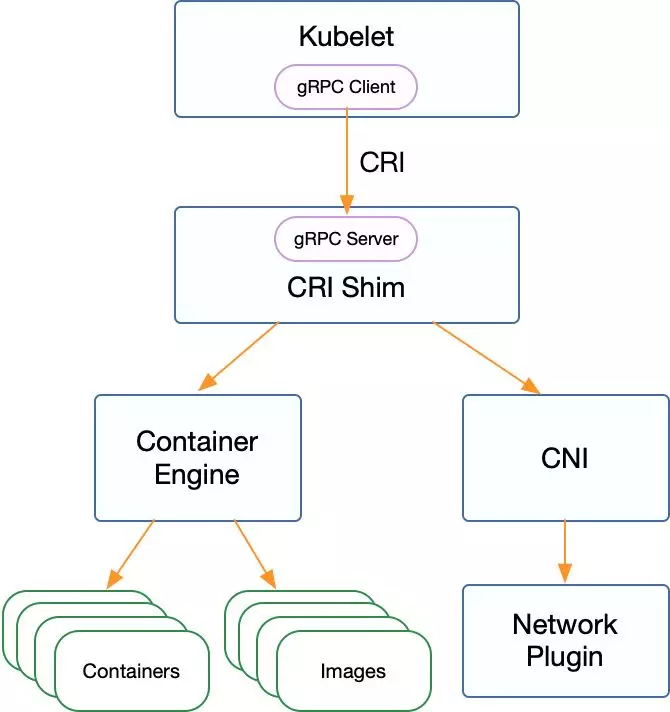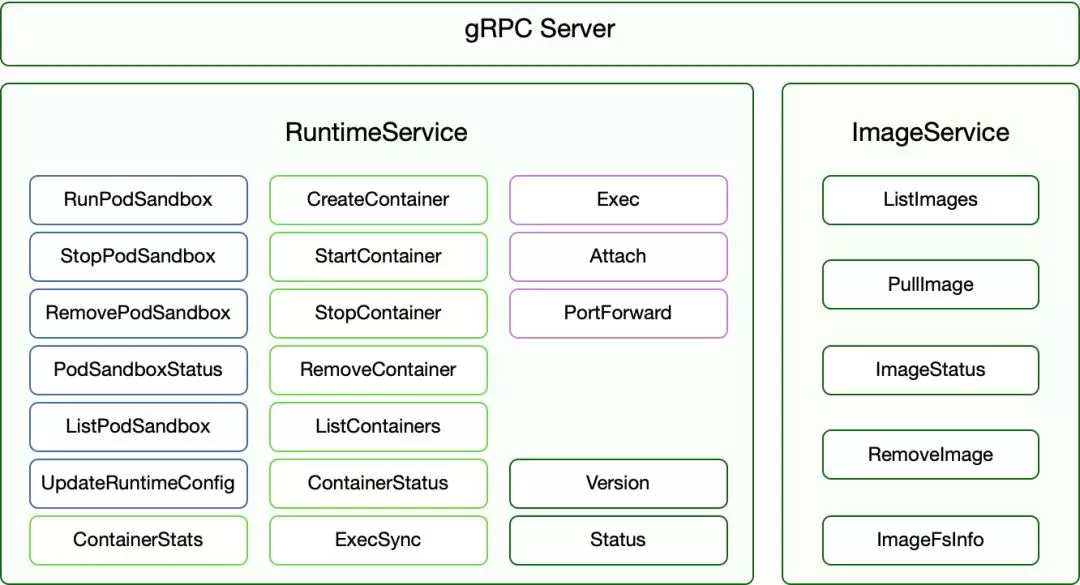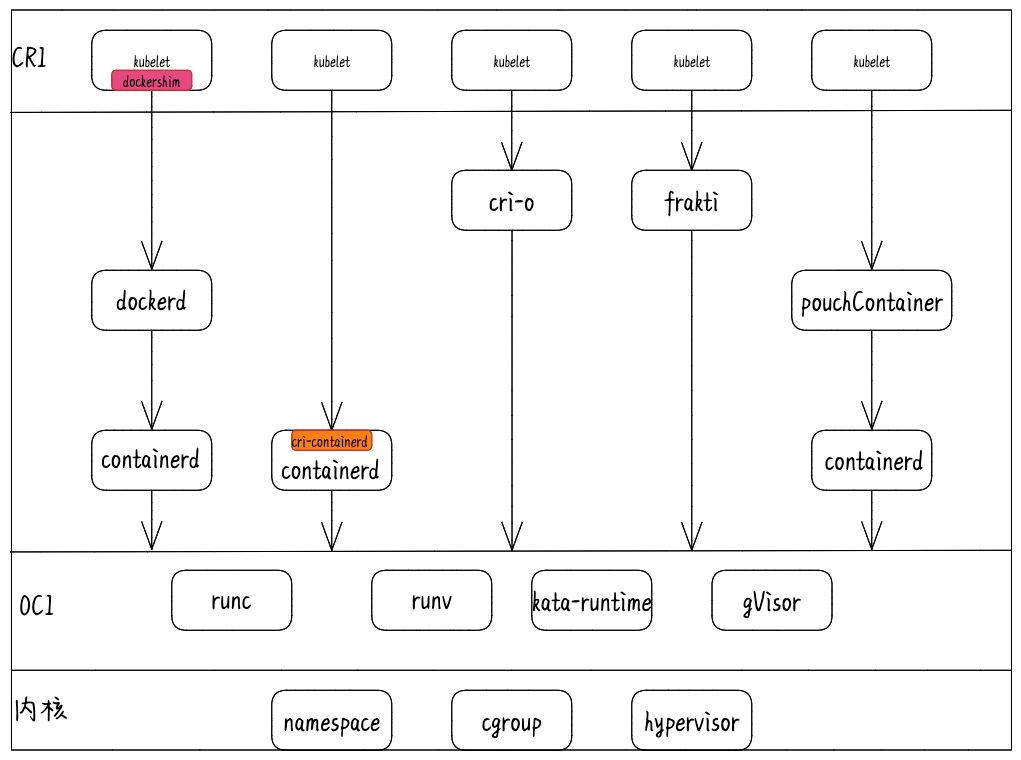微信公众号:运维开发故事,作者:夏老师
kubelet 的组件包括
kubelet 本身,也是按照“控制器”模式来工作的。它实际的工作原理,可以用如下所示的一幅示意图来表示清楚。

- Kubelet Server 对外提供 API,供 kube-apiserver、metrics-server 等服务调用。比如 kubectl exec 时需要通过 Kubelet API /exec/{token} 与容器进行交互;
- Container Manager 管理容器的各种资源,比如 CGroups、QoS、cpuset、device 等;
- Volume Manager 管理容器的存储卷,比如格式化资盘、挂载到 Node 本地、最后再将挂载路径传给容器;
- Eviction 负责容器的驱逐,比如在资源不足时驱逐优先级低的容器,保证高优先级容器的运行;
- cAdvisor 负责为容器提供 Metrics;
- Metrics 和 stats 提供容器和节点的度量数据,比如 metrics-server 通过 /stats/summary 提取的度量数据是 HPA 自动扩展的依据;
- Generic Runtime Manager 是容器运行时的管理者,负责于 CRI 交互,完成容器和镜像的管理;
CRI中定义了容器和镜像的服务的接口,因为容器运行时与镜像的生命周期是彼此隔离的,因此需要定义两个服务。该接口使用Protocol Buffer,基于gRPC,在Kubernetes v1.10+版本中是在pkg/kubelet/apis/cri/runtime/v1alpha2的api.proto中定义的。
CRI架构
Kubernetes 中的容器运行时组成
按照不同的功能可以分为四个部分:
(1)kubelet 中容器运行时的管理,kubeGenericRuntimeManager,它管理与 CRI shim 通信的客户端,完成容器和镜像的管理(代码位置:pkg/kubelet/kuberuntime/kuberuntime_manager.go);
(2)容器运行时接口 CRI,包括了容器运行时客户端接口与容器运行时服务端接口;
(3)CRI shim 客户端,kubelet 持有,用于与 CRI shim 服务端进行通信;
(4)CRI shim 服务端,即具体的容器运行时实现,包括 kubelet 内置的 dockershim (代码位置:pkg/kubelet/dockershim)以及外部的容器运行时remote。如 cri-containerd(用于支持容器引擎containerd)、rktlet(用于支持容器引擎rkt)等。

更普遍的场景,就是你需要在每台宿主机上单独安装一个负责响应 CRI 的组件。这个组件,一般被称作 CRI shim。顾名思义,CRI shim 的工作,就是扮演 kubelet 与容器项目之间的“垫片”(shim)。所以它的作用非常单一,那就是实现 CRI 规定的每个接口,然后把具体的 CRI 请求“翻译”成对后端容器项目的请求或者操作。如下图所示:

CRI gRPC Server的具体实现
Container Runtime实现了CRI gRPC Server,包括RuntimeService和ImageService。该gRPC Server需要监听本地的Unix socket,而kubelet则作为gRPC Client运行。
CRI 接口包括 RuntimeService 和 ImageService 两个服务,这两个服务可以在一个 gRPC server 中实现,也可以分开成两个独立服务。目前社区的很多运行时都是将其在一个 gRPC server 里面实现。这其中包含了两个gRPC服务:

1.RuntimeService:容器和Sandbox运行时管理,
- Streaming Server:提供 streaming API,包括 Exec、Attach、Port Forward;
- CNI 网络插件的支持,用于给容器配置网络;
- 容器引擎管理,比如支持 runc 、containerd 或者支持多个容器引擎。
2.ImageService:提供了从镜像仓库拉取、查看、和移除镜像的RPC。
- 容器和镜像的管理,比如拉取镜像、创建和启动容器等;
看一下源码,Kubernetes 1.20中的CRI接口在api.proto中的定义如下:
// Runtime service defines the public APIs for remote container runtimes
service RuntimeService {
// Version returns the runtime name, runtime version, and runtime API version.
rpc Version(VersionRequest) returns (VersionResponse) {}
// RunPodSandbox creates and starts a pod-level sandbox. Runtimes must ensure
// the sandbox is in the ready state on success.
rpc RunPodSandbox(RunPodSandboxRequest) returns (RunPodSandboxResponse) {}
// StopPodSandbox stops any running process that is part of the sandbox and
// reclaims network resources (e.g., IP addresses) allocated to the sandbox.
// If there are any running containers in the sandbox, they must be forcibly
// terminated.
// This call is idempotent, and must not return an error if all relevant
// resources have already been reclaimed. kubelet will call StopPodSandbox
// at least once before calling RemovePodSandbox. It will also attempt to
// reclaim resources eagerly, as soon as a sandbox is not needed. Hence,
// multiple StopPodSandbox calls are expected.
rpc StopPodSandbox(StopPodSandboxRequest) returns (StopPodSandboxResponse) {}
// RemovePodSandbox removes the sandbox. If there are any running containers
// in the sandbox, they must be forcibly terminated and removed.
// This call is idempotent, and must not return an error if the sandbox has
// already been removed.
rpc RemovePodSandbox(RemovePodSandboxRequest) returns (RemovePodSandboxResponse) {}
// PodSandboxStatus returns the status of the PodSandbox. If the PodSandbox is not
// present, returns an error.
rpc PodSandboxStatus(PodSandboxStatusRequest) returns (PodSandboxStatusResponse) {}
// ListPodSandbox returns a list of PodSandboxes.
rpc ListPodSandbox(ListPodSandboxRequest) returns (ListPodSandboxResponse) {}
// CreateContainer creates a new container in specified PodSandbox
rpc CreateContainer(CreateContainerRequest) returns (CreateContainerResponse) {}
// StartContainer starts the container.
rpc StartContainer(StartContainerRequest) returns (StartContainerResponse) {}
// StopContainer stops a running container with a grace period (i.e., timeout).
// This call is idempotent, and must not return an error if the container has
// already been stopped.
// The runtime must forcibly kill the container after the grace period is
// reached.
rpc StopContainer(StopContainerRequest) returns (StopContainerResponse) {}
// RemoveContainer removes the container. If the container is running, the
// container must be forcibly removed.
// This call is idempotent, and must not return an error if the container has
// already been removed.
rpc RemoveContainer(RemoveContainerRequest) returns (RemoveContainerResponse) {}
// ListContainers lists all containers by filters.
rpc ListContainers(ListContainersRequest) returns (ListContainersResponse) {}
// ContainerStatus returns status of the container. If the container is not
// present, returns an error.
rpc ContainerStatus(ContainerStatusRequest) returns (ContainerStatusResponse) {}
// UpdateContainerResources updates ContainerConfig of the container.
rpc UpdateContainerResources(UpdateContainerResourcesRequest) returns (UpdateContainerResourcesResponse) {}
// ReopenContainerLog asks runtime to reopen the stdout/stderr log file
// for the container. This is often called after the log file has been
// rotated. If the container is not running, container runtime can choose
// to either create a new log file and return nil, or return an error.
// Once it returns error, new container log file MUST NOT be created.
rpc ReopenContainerLog(ReopenContainerLogRequest) returns (ReopenContainerLogResponse) {}
// ExecSync runs a command in a container synchronously.
rpc ExecSync(ExecSyncRequest) returns (ExecSyncResponse) {}
// Exec prepares a streaming endpoint to execute a command in the container.
rpc Exec(ExecRequest) returns (ExecResponse) {}
// Attach prepares a streaming endpoint to attach to a running container.
rpc Attach(AttachRequest) returns (AttachResponse) {}
// PortForward prepares a streaming endpoint to forward ports from a PodSandbox.
rpc PortForward(PortForwardRequest) returns (PortForwardResponse) {}
// ContainerStats returns stats of the container. If the container does not
// exist, the call returns an error.
rpc ContainerStats(ContainerStatsRequest) returns (ContainerStatsResponse) {}
// ListContainerStats returns stats of all running containers.
rpc ListContainerStats(ListContainerStatsRequest) returns (ListContainerStatsResponse) {}
// PodSandboxStats returns stats of the pod. If the pod sandbox does not
// exist, the call returns an error.
rpc PodSandboxStats(PodSandboxStatsRequest) returns (PodSandboxStatsResponse) {}
// ListPodSandboxStats returns stats of the pods matching a filter.
rpc ListPodSandboxStats(ListPodSandboxStatsRequest) returns (ListPodSandboxStatsResponse) {}
// UpdateRuntimeConfig updates the runtime configuration based on the given request.
rpc UpdateRuntimeConfig(UpdateRuntimeConfigRequest) returns (UpdateRuntimeConfigResponse) {}
// Status returns the status of the runtime.
rpc Status(StatusRequest) returns (StatusResponse) {}
}
// ImageService defines the public APIs for managing images.
service ImageService {
// ListImages lists existing images.
rpc ListImages(ListImagesRequest) returns (ListImagesResponse) {}
// ImageStatus returns the status of the image. If the image is not
// present, returns a response with ImageStatusResponse.Image set to
// nil.
rpc ImageStatus(ImageStatusRequest) returns (ImageStatusResponse) {}
// PullImage pulls an image with authentication config.
rpc PullImage(PullImageRequest) returns (PullImageResponse) {}
// RemoveImage removes the image.
// This call is idempotent, and must not return an error if the image has
// already been removed.
rpc RemoveImage(RemoveImageRequest) returns (RemoveImageResponse) {}
// ImageFSInfo returns information of the filesystem that is used to store images.
rpc ImageFsInfo(ImageFsInfoRequest) returns (ImageFsInfoResponse) {}
}
RuntimeService
RuntimeService 则提供了更多的接口,按照功能可以划分为四组:
- PodSandbox 的管理接口:PodSandbox 是对 Kubernete Pod 的抽象,用来给容器提供一个隔离的环境(比如挂载到相同的 CGroup 下面),并提供网络等共享的命名空间。PodSandbox 通常对应到一个 Pause 容器或者一台虚拟机;
- Container 的管理接口:在指定的 PodSandbox 中创建、启动、停止和删除容器;
- Streaming API 接口:包括 Exec、Attach 和 PortForward 等三个和容器进行数据交互的接口,这三个接口返回的是运行时 Streaming Server 的 URL,而不是直接跟容器交互;
- 状态接口:包括查询 API 版本和查询运行时状态。
ImageService
管理镜像的 ImageService 提供了 5 个接口:
- 查询镜像列表;
- 拉取镜像到本地;
- 查询镜像状态;
- 删除本地镜像;
- 查询镜像占用空间等。
这些都很容易映射到 Docker API 或者CRI上面。
CRI相关初始化
跟容器最相关的一个 Manager 是 Generic Runtime Manager,就是一个通用的运行时管理器。我们可以看到目前 dockershim 还是存在于 Kubelet 的代码中的,它是当前性能最稳定的一个容器运行时的实现。remote 指的就是 CRI 接口。CRI 接口主要包含两个部分:
- 一个是 CRI Server,即通用的比如说创建、删除容器这样的接口;
- 另外一个是流式数据的接口 Streaming Server,比如 exec、port-forward 这些流式数据的接口。
sCNI(容器网络接口)也是在 CRI 进行操作的,因为我们在创建 Pod 的时候需要同时创建网络资源然后注入到 Pod 中。接下来就是我们的容器和镜像。我们通过具体的容器创建引擎来创建一个具体的容器。
kubelet中CRI相关初始化逻辑如下:
(1)当kubelet选用dockershim作为容器运行时,则初始化并启动容器运行时服务端dockershim(初始化dockershim过程中也会初始化网络插件CNI)。
- 如果是外部外部容器运行时的时候,需要在每台宿主机上单独安装一个负责响应 CRI 的组件。这个组件就是CRI shim,需要包含网络插件CNI。比如支持containerd的CRI-Containerd的shim。到了 containerd 1.1 版本后就去掉了 CRI-Containerd 这个 shim,直接把适配逻辑作为插件的方式集成到了 containerd 主进程中,所以我们现在可以直接使用–container-runtime-endpoint=unix:///run/containerd/containerd.sock这个套接字,就可以无缝切换的containerd。
(2)初始化容器运行时CRI shim客户端(用于调用CRI shim服务端:内置的容器运行时dockershim或remote容器运行时);
(3)初始化Generic Runtime Manager,用于容器运行时的管理。初始化完成后,后续kubelet对容器以及镜像的相关操作都会通过该结构体持有的CRI shim客户端,与CRI shim服务端进行通信来完成。
下面来简单分析几个比较重要的CRI相关启动参数:
(1)–container-runtime:指定kubelet要使用的容器运行时,可选值docker、remote、rkt (deprecated),默认值为docker,即使用kubelet内置的容器运行时dockershim。当需要使用外部容器运行时,该参数配置为remote,并设置–container-runtime-endpoint参数值为监听的 unix socket位置。
(2)–runtime-cgroups:容器运行时使用的cgroups,可选值。
(3)–docker-endpoint:docker暴露服务的socket地址,默认值为unix:///var/run/docker.sock,该参数配置当且仅当–container-runtime参数值为docker时有效。
(4)–pod-infra-container-image:pod sandbox的镜像地址,默认值为k8s.gcr.io/pause:3.5,该参数配置当且仅当–container-runtime参数值为docker时有效。
(5)–image-pull-progress-deadline:容器镜像拉取超时时间,默认值为1分钟,该参数配置当且仅当–container-runtime参数值为docker时有效。
(6)–experimental-dockershim:设置为true时,启用dockershim模式,只启动dockershim,默认值为false,该参数配置当且仅当–container-runtime参数值为docker时有效。
(7)–experimental-dockershim-root-directory:dockershim根目录,默认值为/var/lib/dockershim,该参数配置当且仅当–container-runtime参数值为docker时有效。
(8)–container-runtime-endpoint:容器运行时的endpoint,linux中默认值为unix:///var/run/dockershim.sock,注意与上面的–docker-endpoint区分开来。
- unix:///var/run/dockershim.sock
- unix:///run/containerd/containerd.sock,即使用本地的containerd作为容器运行时。
- 默认是unix:///var/run/dockershim.sock,即默认使用本地的docker作为容器运行时。
(简单介绍一下socket通信之Unix domain socket:Unix domain socket 又叫 IPC(inter-process communication 进程间通信。用于实现同一主机上的进程间通信。socket 原本是为网络通讯设计的,但后来在 socket 的框架上发展出一种 IPC 机制,就是 UNIX domain socket。虽然网络 socket 也可用于同一台主机的进程间通讯(通过 loopback 地址 127.0.0.1),但是 UNIX domain socket 用于 IPC 更有效率:不需要经过网络协议栈,不需要打包拆包、计算校验和、维护序号和应答等,只是将应用层数据从一个进程拷贝到另一个进程。这是因为,IPC 机制本质上是可靠的通讯,而网络协议是为不可靠的通讯设计的。)
(9)–image-service-endpoint:镜像服务的endpoint,linux中默认值为unix:///var/run/dockershim.sock。
当前支持的CRI后端
我们最初在使用Kubernetes时通常会默认使用Docker作为容器运行时,其实从Kubernetes 1.5开始已经开始支持CRI,目前是处于Alpha版本,通过CRI接口可以指定使用其它容器运行时作为Pod的后端,docker、containerd、CRI-O、Frakti、pouch,它们衔接Kubelet与运行时方式对比如下:

弃用 docker 后到底会产生什么影响
-
正常的 K8s 用户不会有任何影响
生产环境中高版本的集群只需要把运行时从 docker 切换到 containerd即可。containerd 是 docker 中的一个底层组件,主要负责维护容器的生命周期,跟随 docker 经历了长期考验。同时 2019年初就从 CNCF 毕业,可以单独作为容器运行时用在集群中。到了 containerd 1.1 版本后就去掉了 CRI-Containerd 这个 shim,直接把适配逻辑作为插件的方式集成到了 containerd 主进程中,所以我们现在可以直接使用–container-runtime-endpoint=unix:///run/containerd/containerd.sock这个套接字,就可以无缝切换的containerd。因此把 runtime 从 docker 转换到 containerd 是一个基本无痛的过程。
-
开发环境中通过docker build构建出来的镜像依然可以在集群中使用
镜像一直是容器生态的一大优势,虽然人们总是把镜像称之为“docker镜像”,但镜像早就成为了一种规范了。具体规范可以参考image-spec。在任何地方只要构建出符合 Image Spec 的镜像,就可以拿到其他符合 Image Spec 的容器运行时上运行。如果你是一名开发/运维人员,你依旧可以继续使用 Docker 来构建镜像,以相同的方式将镜像推送到 Registry,并且将这些镜像部署到你的 Kubernetes 中;如果你是运行和操作集群的用户,你只需要将 Docker 切换成你需要的containerd 容器运行时即可。
-
在 Pod 中使用 DinD(Docker in Docker)的用户会受到影响
1.有些使用者会把 docker 的 socket (/run/docker.sock)挂载到 Pod 中,并在 Pod 中调用 docker 的 api 构建镜像或创建编译容器等,官方在这里的建议是使用 Kaniko、Img 或 Buildah。
2.我们可以通过把 docker daemon 作为 DaemonSet 或者给想要使用 docker 的 Pod 添加一个 docker daemon 的 sidecar 的方式在任意运行时中使用 DinD 的方案。
3.同一集群中docker 节点与 containerd 节点共存,通过按节点标签调度,保证这类业务调度到 docker 节点没有通过上述方案。
预告
后期会围绕runc,shim等探索容器的底层实现与管理API的暴露。敬请期待!!!!
reference
https://feisky.xyz/posts/kubernetes-container-runtime/
https://jimmysong.io/kubernetes-handbook/concepts/cri.html
https://github.com/kubernetes/enhancements/tree/master/keps/sig-node/2221-remove-dockershim
https://kubernetes.io/zh/docs/setup/production-environment/container-runtimes/
https://www.qikqiak.com/post/containerd-usage/
https://kubernetes.io/zh/blog/2020/12/02/dockershim-faq/
https://github.com/containerd
https://www.zhihu.com/question/324124344






















 1024
1024

 被折叠的 条评论
为什么被折叠?
被折叠的 条评论
为什么被折叠?








